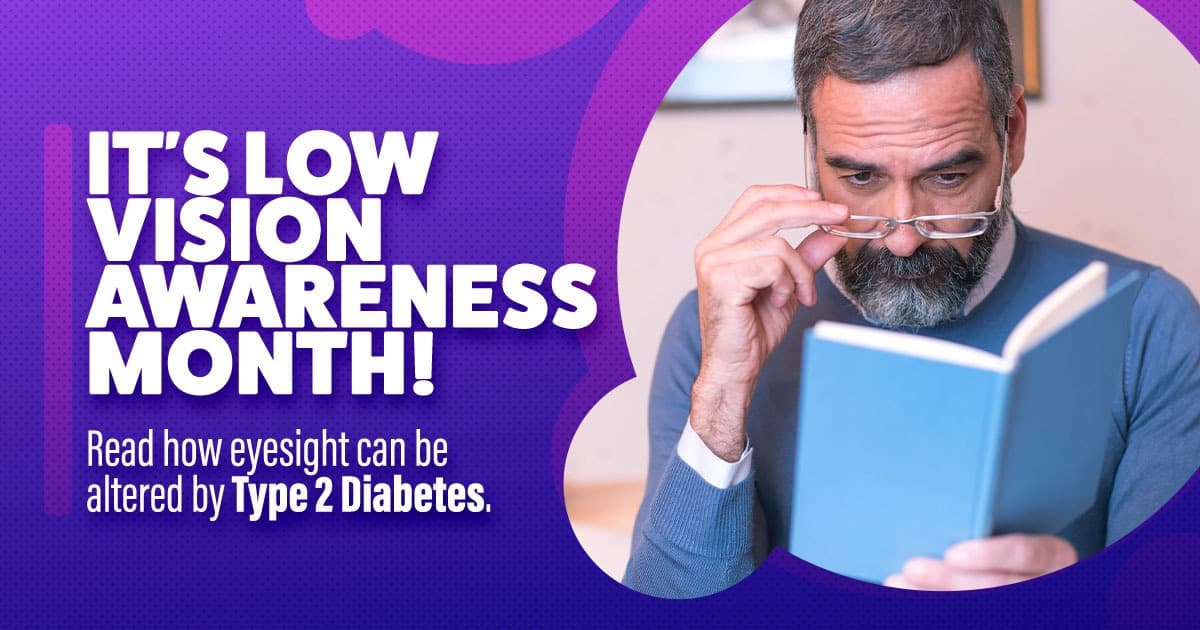Vision impairment can make it hard to do everyday things like reading, shopping, and cooking. Approximately 4.2 million Americans ages 40 and older are visually impaired. Of these, 3 million have low vision. February is Low Vision Awareness Month. Retinopathy is a leading cause of vision loss and one of the many ways type 2 diabetes can impact the whole body.
What is Low Vision?
Low vision is when a person has difficulty seeing despite standard treatments like regular glasses, contact lenses, medicine, or surgery. Most people with low vision are age 65 or older. In older adults, the leading causes of vision loss are age-related macular degeneration, diabetic retinopathy, cataract, and glaucoma.
Inherited eye conditions, infectious, autoimmune eye diseases, or trauma are the most common cause of vision loss in younger individuals.
Diabetes and Eyesight
Eye diseases that can affect individuals living with diabetes include diabetic retinopathy, macular edema, cataracts, and glaucoma. These are caused when high blood sugar damages blood vessels in the retina. Damaged blood vessels can swell and leak, causing blurry vision or halting blood flow. Sometimes new blood vessels will form, but they grow abnormally and cause further vision problems.

All can lead to vision loss, but early diagnosis and treatment can go a long way toward protecting your eyesight. Symptoms include:
- Blurry vision
- Spots or dark shapes in your vision (floaters)
- Trouble seeing colors
- Dark or empty areas in your vision
- Vision loss
Maximizing Remaining Eyesight and Prevention
For people with low vision, maximizing their remaining sight is key to helping them continue to live safe, productive, and rewarding lives. Getting help is the first step. You can protect your vision and lower your chance for vision loss with these steps recommended by the CDC:
- Get a dilated eye exam at least once a year so your eye doctor can spot any problems early when they’re most treatable.

- Keep your blood sugar levels in your target range as much as possible. Over time, high blood sugar not only damages blood vessels in your eyes it can also affect the shape of your lenses and make your vision blurry.
- Keep your blood pressure and cholesterol levels in your target range to lower your risk for eye diseases and vision loss. Also great for your health in general!
- Quit smoking. Quitting lowers your risk for diabetes-related eye diseases and improves your health in many other ways too.
- Get active. Physical activity protects your eyes and helps you manage diabetes.
- Ask your doctor to refer you to diabetes self-management education and support (DSMES) People who receive less diabetes education are twice as likely to get diabetic retinopathy as people who receive more education.

Charlottesville Medical Research is looking for individuals to participate in currently enrolling type 2 diabetes studies. If you’re looking to help prioritize your health and advance options for diabetes, research studies may be an option. To learn more, call us at (434) 817-2442, or visit our website today!
Sources:
https://lighthouseguild.org/low-vision-awareness-month/
https://www.diabetes.org/diabetes/eye-health/vision-loss-diabetes
https://www.nei.nih.gov/learn-about-eye-health/eye-conditions-and-diseases/diabetic-retinopathy


